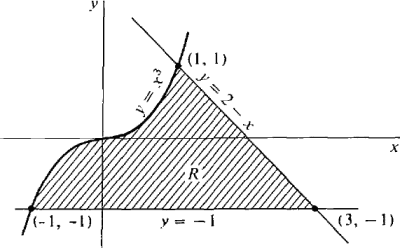| The ebook Elementary Calculus is based on material originally written by H.J. Keisler. For more information please read the copyright pages. |

|

Home  Integral Integral  Area between two Curves Area between two Curves  Examples Examples  Example 3: Area Below A Curve And A Line Example 3: Area Below A Curve And A Line |
|






|
|
Example 3: Area Below A Curve And A Line
Find the area of the region R bounded below by the line y = - 1 and above by the curves y = x3 and y = 2 - x. The region is shown in Figure 4.5.6.
Figure 4.5.6 This problem can be solved in three ways. Each solution illustrates a different trick which is useful in other area problems. The three corners of the region are: (- 1, - 1), where y = x3 and y = -1 cross. (3, - 1), where y = 2 - x and y = - 1 cross. (1, 1), where y = x3 and y = 2 - x cross. Note that y = x3 and y = 2 - x can cross at only one point because x3 is always increasing and 2 - x is always decreasing. FIRST SOLUTIONBreak the region into the two parts shown in Figure 4.5.7: R1 from x = - 1 to x = 1, and R2 from x = 1 to x = 3. Then area of R =area of Rt + area of R2. area of R1 = area of R, = area of R = 2 + 2 = 4.
Figure 4.5.7 SECOND SOLUTIONForm the triangular region S between y = -1 and y = 2 - x from -1 to 3. The region R is obtained by subtracting from S the region S1 shown in Figure 4.5.8. Then area of R = area of S - area of S1
area of R = 8 - 4 = 4. .
Figure 4.5.8 THIRD SOLUTIONUse y as the independent variable and x as the dependent variable. Write the boundary curves with x as a function of y. y = 2 - x becomes x = 2 - y. y = x3 becomes x = y1/3. The limits of integration are y = - 1 and y = 1 (see Figure 4.5.9). Then
Figure 4.5.9 As expected, all three solutions gave the same answer.
|
|
Home  Integral Integral  Area between two Curves Area between two Curves  Examples Examples  Example 3: Area Below A Curve And A Line Example 3: Area Below A Curve And A Line |
|
Last Update: 2006-11-15



 = 2.
= 2. = 2.
= 2.




